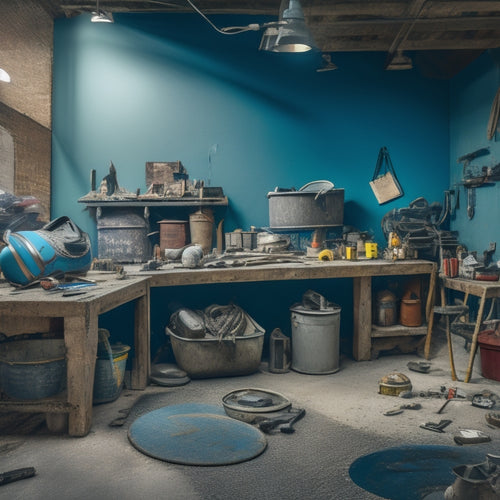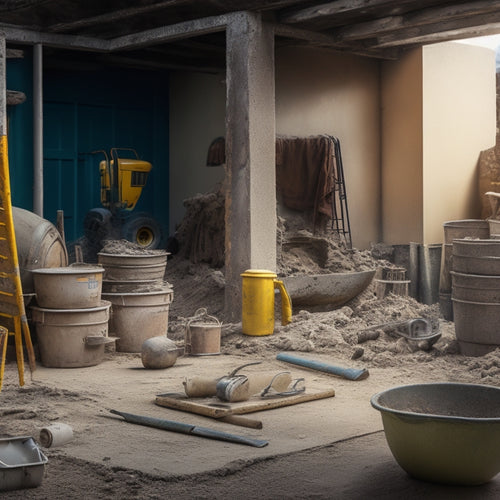
Reinforcement Tools Checklist for Concrete Block Walls
Share
You'll need a range of reinforcement materials, including horizontal and vertical rebar, fiber mesh, and anchor bolts, to guarantee your concrete block walls can resist various forces. Masonry reinforcement accessories like wire ties, joint reinforcement, and wall ties are also essential. To get the job done, you'll require placement tools such as spirit levels, wire cutters, and notched trowels. Additionally, specialized equipment like rebar benders and shears can enhance your control over reinforcement techniques. Make sure you have all the necessary tools and equipment to ensure a sturdy and durable concrete block wall structure, and uncover more details on how to effectively implement them.
Key Takeaways
• Ensure precise alignment with spirit levels and laser levels to secure reinforcement placement.
• Use wire cutters and wire twisters to shape reinforcement wires accurately and efficiently.
• Utilize block pullers or wall tie installers for secure anchoring of reinforcement materials.
• Implement specialized equipment like rebar benders, shears, and tiers for efficient fabrication and placement.
• Maintain accurate measurements with tape measures and calculators to ensure correct reinforcement placement.
Essential Reinforcement Materials Needed
You'll need to gather crucial reinforcement materials to confirm your concrete block wall can withstand various loads and stresses. The type of reinforcement you choose will depend on the design factors of your project.
For instance, if you're building a retaining wall, you'll need to use reinforcement that can resist lateral pressure. In this case, you might opt for horizontal reinforcement, such as rebar or fiber mesh, to provide added strength and stability.
On the other hand, if you're building a load-bearing wall, you'll need to use reinforcement that can support vertical loads. Here, you might choose vertical reinforcement, like rebar or anchor bolts, to transfer the weight of the structure to the foundation.
It's vital to take into account the specific requirements of your project when selecting reinforcement materials. By doing so, you'll confirm that your concrete block wall can withstand the forces acting upon it.
Masonry Reinforcement Accessories
What other components do you need to confirm a strong bond between the reinforcement materials and the concrete blocks?
Besides the essential reinforcement materials, you'll require masonry reinforcement accessories to guarantee wall stability. These accessories play a significant role in maintaining the integrity of your concrete block wall.
You'll need wire ties or joint reinforcement to secure the reinforcement materials to the blocks. These ties prevent the reinforcement from shifting during the concrete pouring process, confirming a strong bond between the materials.
Additionally, masonry jointing tools, such as joint spacers and joint fillers, are necessary for proper masonry jointing. These tools help maintain uniform joint widths and guarantee the correct alignment of blocks.
Other essential accessories include wall ties, which connect the masonry wall to the surrounding structure, and masonry anchors, which secure the wall to the foundation.
Don't forget to include a level and a string line to confirm accurate block placement and alignment.
Block Wall Reinforcement Systems
With the masonry reinforcement accessories in place, the next step is to implement a block wall reinforcement system that effectively resists lateral loads and provides additional structural integrity to your concrete block wall. This system is essential in enhancing the overall block wall benefits, including increased strength, durability, and resistance to natural disasters like earthquakes and hurricanes.
You'll need to choose from various reinforcement techniques, such as horizontal joint reinforcement, vertical reinforcement, and shear reinforcement.
Horizontal joint reinforcement involves placing reinforcement materials, like wire mesh or fiber mesh, between courses of blocks to resist lateral loads.
Vertical reinforcement, on the other hand, involves placing rebar or other reinforcement materials within the block cores to provide additional strength.
Shear reinforcement, which involves placing diagonal reinforcement materials, helps to resist shear forces.
Reinforcement Placement Tools Required
Implementing a block wall reinforcement system requires having the right tools to facilitate accurate placement of reinforcement materials, guaranteeing that your concrete block wall meets the required building codes and regulations.
You'll need a set of essential tools to guarantee proper reinforcement placement. A spirit level and a laser level will help you achieve precise alignment and verticality during installation.
A tape measure and a calculator are necessary for accurate measurement and calculation of reinforcement material quantities. You'll also need a wire cutter and a wire twister for cutting and shaping reinforcement wires to fit your wall design.
Additionally, a block puller or a wall tie installer will come in handy for securely anchoring reinforcement materials to the block wall.
When it comes to installation techniques, a notched trowel and a level are vital for achieving a smooth, even surface during grout filling.
Specialized Reinforcement Equipment
You'll require specialized reinforcement equipment, including a rebar bender and a rebar shear, to fabricate and cut reinforcement bars to precise lengths and angles, ensuring a customized fit for your concrete block wall design. These machines are essential for achieving the exact reinforcement techniques your project demands.
With a rebar bender, you can create complex bends and curves, while a rebar shear enables you to cut bars to exact lengths, minimizing waste and optimizing material usage.
In addition to these fundamental machines, you may also need specialized machinery, such as a rebar tier, to streamline the reinforcement process. By investing in these tools, you'll gain greater control over your project's reinforcement techniques, ensuring that your concrete block wall meets the required strength and durability standards.
With the right equipment, you can efficiently fabricate and place reinforcement bars, resulting in a high-quality finish and reduced construction time. By incorporating these specialized tools into your workflow, you'll be able to tackle complex projects with confidence and precision.
Frequently Asked Questions
What Is the Minimum Compressive Strength Required for Concrete Blocks?
You're looking for the minimum compressive strength required for concrete blocks.
When it comes to block strength testing, you need to confirm your blocks meet the compressive strength standards.
According to industry standards, the minimum compressive strength for concrete blocks is 1,900 pounds per square inch (psi).
This is the benchmark for load-bearing blocks, and you should verify this through testing to ensure the structural integrity of your construction project.
Can I Use Rebar for Walls Below Grade Level?
You're wondering if you can use rebar for walls below grade level. The answer is, it's not recommended.
Rebar corrosion is a major concern in below-grade applications, where moisture and soil chemicals can accelerate rust. This can compromise the structural integrity of your block wall reinforcement.
Instead, consider using epoxy-coated or stainless steel rebar, or alternative reinforcement materials specifically designed for below-grade use.
How Do I Ensure Correct Anchor Bolt Placement?
As you commence on building your wall, anchor bolt placement is essential, like a conductor leading an orchestra - every element must be in harmony.
To guarantee correct placement, you'll need to choose the right anchor bolt type for your project, such as epoxy or mechanical anchors.
Then, employ precise placement techniques, like marking the center of the bolt hole or using a template to maintain accurate spacing.
What Is the Recommended Spacing for Horizontal Joint Reinforcement?
When implementing horizontal reinforcement techniques, you'll want to guarantee proper joint spacing guidelines.
Typically, you should space horizontal joint reinforcement at 16 inches on-center, but this may vary depending on local building codes, wall height, and loading conditions.
Always check the manufacturer's recommendations and consult local authorities to determine the ideal spacing for your specific project.
Are There Any Specific OSHA Regulations for Block Wall Construction?
You're likely aware that the construction industry accounts for nearly 20% of all workplace fatalities.
When it comes to block wall construction, you must comply with OSHA regulations to guarantee a safe working environment.
Specifically, you'll need to provide safety training on hazards such as falling blocks and equipment, as well as implement fall protection measures like guardrails and safety nets.
Conclusion
You've got the blueprint for a sturdy concrete block wall, but without the right reinforcement tools, it's like building on shaky ground.
Guarantee your structure stands the test of time by crossing off every item on this checklist.
From essential materials to specialized equipment, don't leave a single detail to chance.
With this extensive guide, you'll be well-equipped to construct a wall that's as strong as a fortress.
Related Posts
-

What Tools Do You Need for Concrete Flooring
You'll need a thorough arsenal of specialized tools to achieve a high-quality, professional-looking concrete floor, i...
-

Top Mixing Tools for DIY Concrete Block Laying
When it comes to DIY concrete block laying, the right mixing tools are vital for a strong and durable structure. You'...
-

What Tools Are Needed for Concrete Wall Foundations
You'll need a thorough array of tools and equipment to construct a concrete wall foundation that meets structural int...


